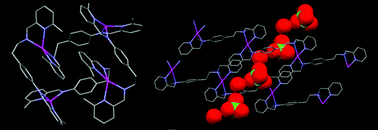The supramolecular self-assembly structures of one tetranuclear silver(I) complex and three silver(I) coordination polymers derived from bis-bidentate imino-pyridine ligands and their reduced N-methyl derivatives are discussed. Six new ligands were synthesised, and the X-ray structural analysis of L1, L2 and L5 with silver(I) ions indicated the formation of 1D coordination polymers, namely {[AgL1]BF4}n (1), {[AgL2]ClO4}n (2), and {[AgL5]ClO4·H2O}n (5), whereas ligand L4 led to a tetranuclear complex {[AgL4]ClO4}4 (4). L1 is the Schiff-base derived from the condensation of α,α′-diamino-m-xylene and pyridine-2-carboxaldehyde and L4 that resulting from the reaction of 2-(4-aminophenyl)ethylamine with 6-methyl-pyridine-2-carboxaldehyde, while L2 and L5 are the reduced N-methyl derivatives. The structural determination shows achiral syndiotactic polymers for 1 and chiral isotactic for 2 and 5. The 1D coordination chains of 1 are stabilised by intramolecular π–π stacking interactions between the phenyl ring of a spacer with the pyridine of a symmetry related adjacent ligand, while the crystal packing of 5 show inter-chain π–π interactions. Compound 4 comprises discrete tetranuclear [AgL4]44+ complex cations and the rhomboid disposition of the metal ions leads to a globular arrangement of the silver(I) complex. The results provide an insight about the effect of ligand spacer length and flexibility in stabilising the metallo-supramolecular architecture.

